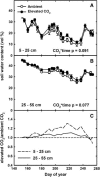Photosynthesis, productivity, and yield of maize are not affected by open-air elevation of CO2 concentration in the absence of drought
- PMID: 16407441
- PMCID: PMC1361343
- DOI: 10.1104/pp.105.073957
Photosynthesis, productivity, and yield of maize are not affected by open-air elevation of CO2 concentration in the absence of drought
Abstract
While increasing temperatures and altered soil moisture arising from climate change in the next 50 years are projected to decrease yield of food crops, elevated CO2 concentration ([CO2]) is predicted to enhance yield and offset these detrimental factors. However, C4 photosynthesis is usually saturated at current [CO2] and theoretically should not be stimulated under elevated [CO2]. Nevertheless, some controlled environment studies have reported direct stimulation of C4 photosynthesis and productivity, as well as physiological acclimation, under elevated [CO2]. To test if these effects occur in the open air and within the Corn Belt, maize (Zea mays) was grown in ambient [CO2] (376 micromol mol(-1)) and elevated [CO2] (550 micromol mol(-1)) using Free-Air Concentration Enrichment technology. The 2004 season had ideal growing conditions in which the crop did not experience water stress. In the absence of water stress, growth at elevated [CO2] did not stimulate photosynthesis, biomass, or yield. Nor was there any CO2 effect on the activity of key photosynthetic enzymes, or metabolic markers of carbon and nitrogen status. Stomatal conductance was lower (-34%) and soil moisture was higher (up to 31%), consistent with reduced crop water use. The results provide unique field evidence that photosynthesis and production of maize may be unaffected by rising [CO2] in the absence of drought. This suggests that rising [CO2] may not provide the full dividend to North American maize production anticipated in projections of future global food supply.
Figures






Similar articles
-
Impairment of C(4) photosynthesis by drought is exacerbated by limiting nitrogen and ameliorated by elevated [CO(2)] in maize.J Exp Bot. 2011 May;62(9):3235-46. doi: 10.1093/jxb/err056. Epub 2011 Mar 11. J Exp Bot. 2011. PMID: 21398428
-
Canopy warming caused photosynthetic acclimation and reduced seed yield in maize grown at ambient and elevated [CO2 ].Glob Chang Biol. 2015 Nov;21(11):4237-49. doi: 10.1111/gcb.13013. Epub 2015 Sep 23. Glob Chang Biol. 2015. PMID: 26119211
-
Future carbon dioxide concentration decreases canopy evapotranspiration and soil water depletion by field-grown maize.Glob Chang Biol. 2013 May;19(5):1572-84. doi: 10.1111/gcb.12155. Epub 2013 Mar 5. Glob Chang Biol. 2013. PMID: 23505040
-
Rising atmospheric carbon dioxide concentration and the future of C4 crops for food and fuel.Proc Biol Sci. 2009 Jul 7;276(1666):2333-43. doi: 10.1098/rspb.2008.1517. Epub 2009 Feb 25. Proc Biol Sci. 2009. PMID: 19324804 Free PMC article. Review.
-
30 years of free-air carbon dioxide enrichment (FACE): What have we learned about future crop productivity and its potential for adaptation?Glob Chang Biol. 2021 Jan;27(1):27-49. doi: 10.1111/gcb.15375. Epub 2020 Nov 2. Glob Chang Biol. 2021. PMID: 33135850 Review.
Cited by
-
Overexpression of Thellungiella halophila H+-pyrophosphatase gene improves low phosphate tolerance in maize.PLoS One. 2012;7(8):e43501. doi: 10.1371/journal.pone.0043501. Epub 2012 Aug 30. PLoS One. 2012. PMID: 22952696 Free PMC article.
-
Interactive Impact of Arbuscular Mycorrhizal Fungi and Elevated CO2 on Growth and Functional Food Value of Thymus vulgare.J Fungi (Basel). 2020 Sep 9;6(3):168. doi: 10.3390/jof6030168. J Fungi (Basel). 2020. PMID: 32916889 Free PMC article.
-
Effects of elevated carbon dioxide on plant growth and leaf photosynthesis of annual ryegrass along a phosphorus deficiency gradient.Front Plant Sci. 2023 Nov 27;14:1271262. doi: 10.3389/fpls.2023.1271262. eCollection 2023. Front Plant Sci. 2023. PMID: 38089800 Free PMC article.
-
Evolution of C4 photosynthesis predicted by constraint-based modelling.Elife. 2019 Dec 4;8:e49305. doi: 10.7554/eLife.49305. Elife. 2019. PMID: 31799932 Free PMC article.
-
Water Deficit Modulates the CO2 Fertilization Effect on Plant Gas Exchange and Leaf-Level Water Use Efficiency: A Meta-Analysis.Front Plant Sci. 2021 Nov 29;12:775477. doi: 10.3389/fpls.2021.775477. eCollection 2021. Front Plant Sci. 2021. PMID: 34912360 Free PMC article.
References
-
- Ainsworth EA, Davey PA, Bernacchi CJ, Dermody OC, Heaton EA, Moore DJ, Morgan PB, Naidu SL, Ra HSY, Zhu XG, et al (2002) A meta-analysis of elevated [CO2] effects on soybean (Glycine max) physiology, growth and yield. Glob Change Biol 8: 695–709
-
- Ainsworth EA, Long SP (2005) What have we learned from 15 years of free-air CO2 enrichment (FACE)? A meta-analytic review of the responses of photosynthesis, canopy properties and plant production to rising CO2. New Phytol 165: 351–371 - PubMed
-
- Allen LH, Boote KJ, Jones JW, Jones PH, Valle RR, Acock B, Rogers HH, Dahlman RC (1987) Response of vegetation to rising carbon dioxide: photosynthesis, biomass and seed yield of soybean. Global Biogeochem Cycles 1: 1–14
-
- Arp WJ (1991) Effects of source-sink relations on photosynthetic acclimation to elevated CO2. Plant Cell Environ 14: 869–875
-
- Ashton AR, Burnell JN, Furbank RT, Jenkins CLD, Hatch MD (1990) Enzymes of C4 photosynthesis. In PJ Lea, ed, Methods in Plant Biochemistry, Vol 3. Academic Press, New York, pp 39–72
Publication types
MeSH terms
Substances
LinkOut - more resources
Full Text Sources
Miscellaneous

